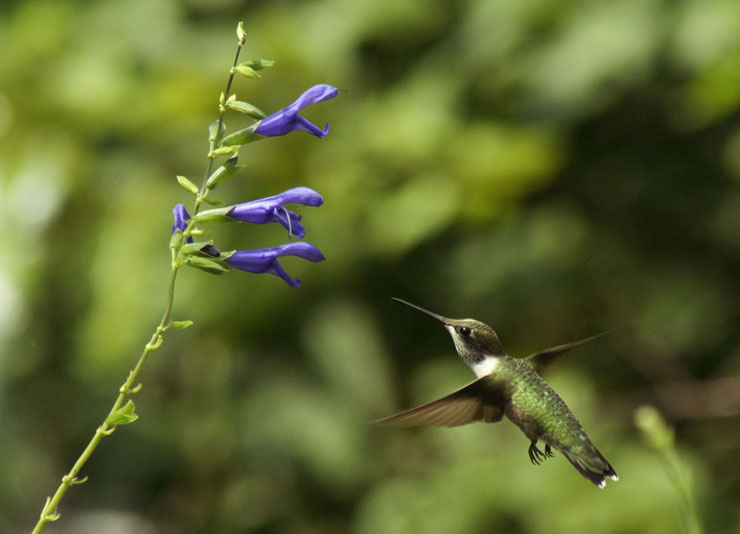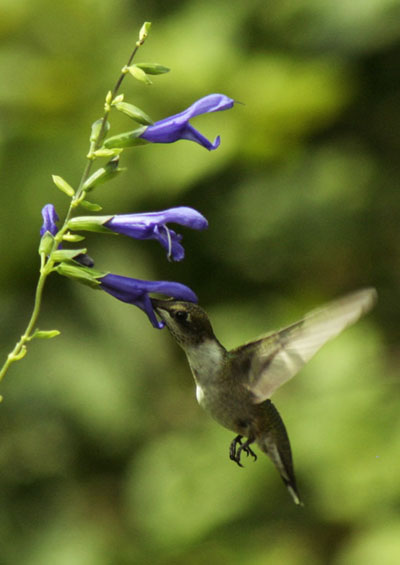
Yesterday was definitely not the day to really be tackling this, but I spent a little time down at the North Carolina Botanical Garden in Chapel Hill, and still managed to get a couple of useful images while there. The sun was hiding behind either heavy haze or clouds while the temperature hovered in the high nineties, and the sweat was pouring off of me. Worse, though, was the light quality – a little haze is actually useful, because it softens both the highlights and the shadows and provides a contrast that can be handled easier, but heavy haze mutes the color and turns everything a bit bluer. It also reduces the light by a few stops, which can make photos of fast subjects tricky to get.
 Taking advantage of some light shade from a tree near this bush, I waited out the visits from the ruby-throated hummingbirds (Archilochus colubris.) Both of these photos were handheld with a 75-300 IS lens at 300mm, but I’d bumped the ISO up to 400 to give me a bit more of a useful working space. The shade also helped me be a little more discreet in the four-to-five meter (15 foot) working distance to the birds. You’re looking at the two best images from 36 attempts – hummingbirds are hyperactive fliers, and this one was not staying in one position longer than a second, most times less, as she sampled a large number of flowers on each visit. You might think I’m crazy for this fact, too, but I was shooting manual focus. With a small and rapid subject, autofocus can too easily lose the correct focus point and rack throughout its entire travel trying to regain it, which is simply time wasted – meanwhile, you’ve lost the subject entirely because the focus in the viewfinder is either a few feet in front of you, or infinity. So I go with manual focus, which is “slower” but lets me track focus without going too far astray and losing sight of my subject.
Taking advantage of some light shade from a tree near this bush, I waited out the visits from the ruby-throated hummingbirds (Archilochus colubris.) Both of these photos were handheld with a 75-300 IS lens at 300mm, but I’d bumped the ISO up to 400 to give me a bit more of a useful working space. The shade also helped me be a little more discreet in the four-to-five meter (15 foot) working distance to the birds. You’re looking at the two best images from 36 attempts – hummingbirds are hyperactive fliers, and this one was not staying in one position longer than a second, most times less, as she sampled a large number of flowers on each visit. You might think I’m crazy for this fact, too, but I was shooting manual focus. With a small and rapid subject, autofocus can too easily lose the correct focus point and rack throughout its entire travel trying to regain it, which is simply time wasted – meanwhile, you’ve lost the subject entirely because the focus in the viewfinder is either a few feet in front of you, or infinity. So I go with manual focus, which is “slower” but lets me track focus without going too far astray and losing sight of my subject.
Film would probably have made the colors better, but with the nature of such a subject, digital wins handily – I try not to discard entire rolls of worthless shots, and that’s pretty close to what would have happened here. Also, my preferred films are much slower than ISO 400 (like 40 to 80) which might have meant motion blur, or at least having to use a flash, which would then have affected the background appearance.
There was one other technique I could have used, which stands the greatest chance of producing sharp images, and that’s to choose a particular branch of blossoms, lock the camera on a tripod framed and focused on them, and wait for the hummingbird to “pose” at my chosen branch. Naturally, this can take no small amount of time, and in the heat I didn’t have the patience to stake out a particular blossom. Still, I can’t complain about what I did capture.
One other little bit of trivia: the bottom photo actually came before the top photo, and she likely backed away from the blossom on hearing the sound of the camera.




















































